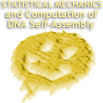Speaker
Prof.
David Soloveichik
(University of Washington)
Description
What challenges must be overcome before engineers can design
molecules and their interactions with ease? The ideas of
abstraction and modularity allowed the creation of software
and hardware systems of extreme complexity consisting of
millions of lines of code and hundreds of millions of
transistors. Mimicking software and hardware engineering, an
approach to the molecular challenge is to find a basic set
of interactions that can be composed in various ways without
interference, and then create a hierarchy of modules of
increasing complexity leading to the desired higher-level
function.
Nucleic acids are a very promising candidate for the
underlying molecular substrate for such modular systems,
and have been used to construct a variety of nanoscale
structures, mechanical nanomachines, sensors, and
information processing devices. Nucleic acids are also
biologically compatible and potentially capable of
interfacing with existing cellular machinery, hinting at the
eventual possibility of therapeutic applications.
"Strand-displacement cascades" describes the technology
combining toehold-mediated branch migration,
toehold blocking by hybridization, and toehold exchange, to
enable coupled cascades of strand displacement reactions.
The promise of this technology is that all the necessary
nucleic acid interactions can be systematically programmed
using a few simple rules, and composed into hierarchically
assembled complex systems.
My talk will review developments both in the theory and
experimental practice of strand displacement cascades.
Computer theoretic abstractions have had a key role in
thinking about strand displacement cascades: chemical
reaction networks, process algebras, digital circuits, state
machines, as well as special-purpose algebras have all been
harnessed as organizing principles. I will review the
utility of such abstractions for the engineering of complex
networks of molecular interactions, focusing particularly on
chemical reaction networks as an intermediate abstraction
layer (eg how digital circuits can be compiled to chemical
reaction networks which in turn can be compiled to strand
displacement cascades). I will also review the art of
designing domain sequences, as well as the available
modeling and simulation tools, and outline our first steps
toward experimentally realizing certain dynamical systems
such as oscillators that may become parts of future embedded
control modules. In the final part of the talk I will review
the substantial remaining engineering challenges.
Primary author
Prof.
David Soloveichik
(University of Washington)

